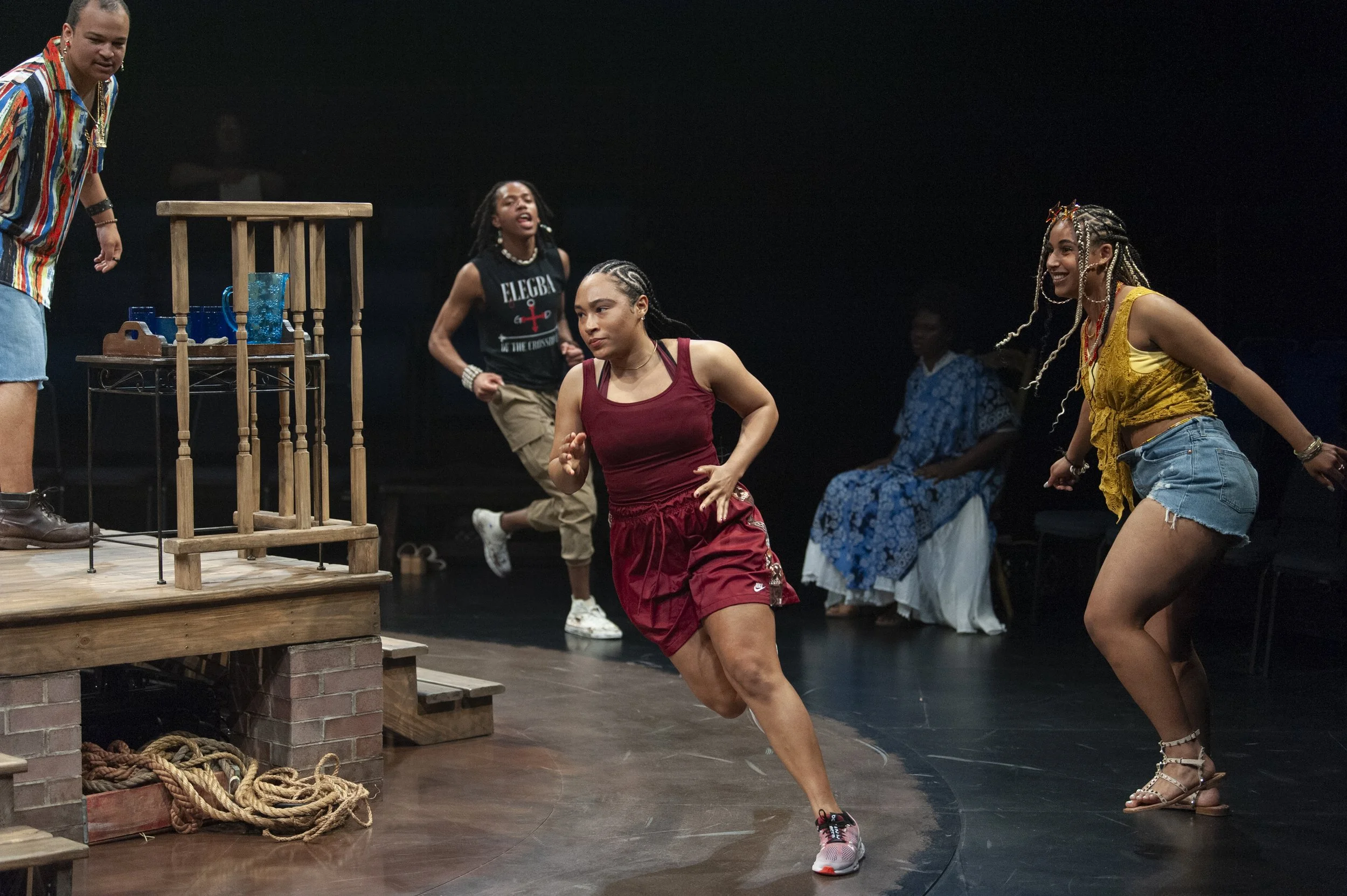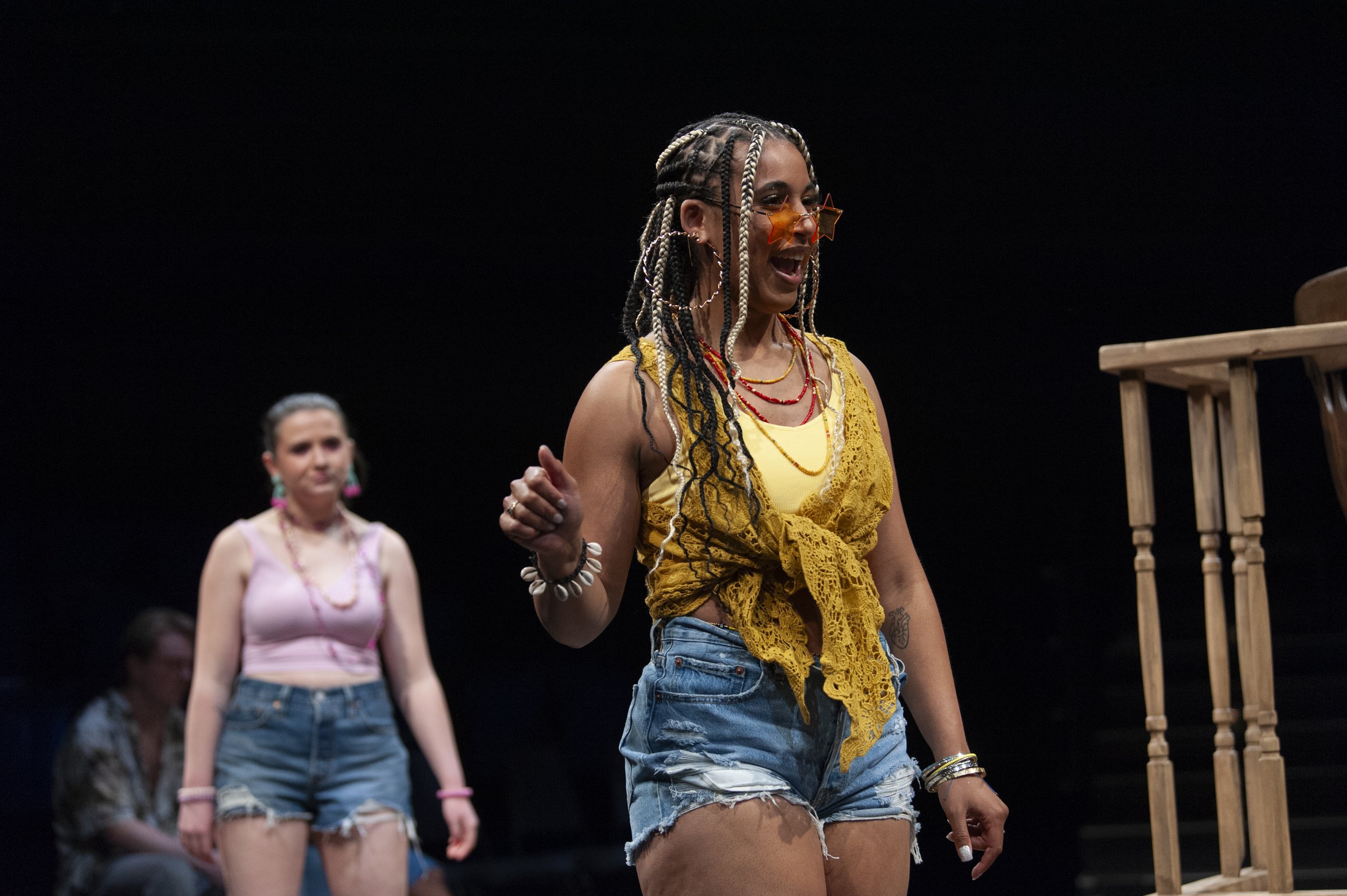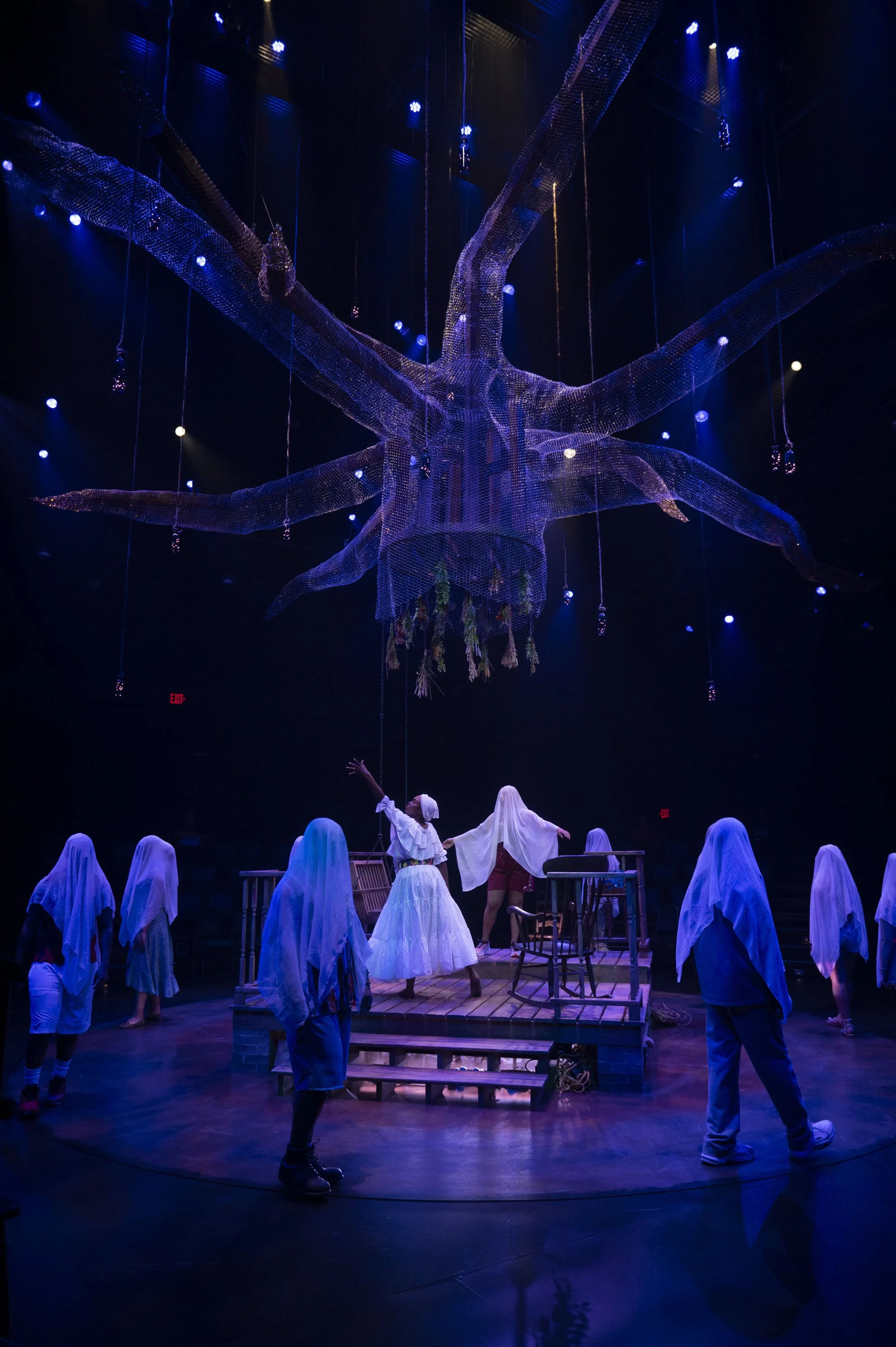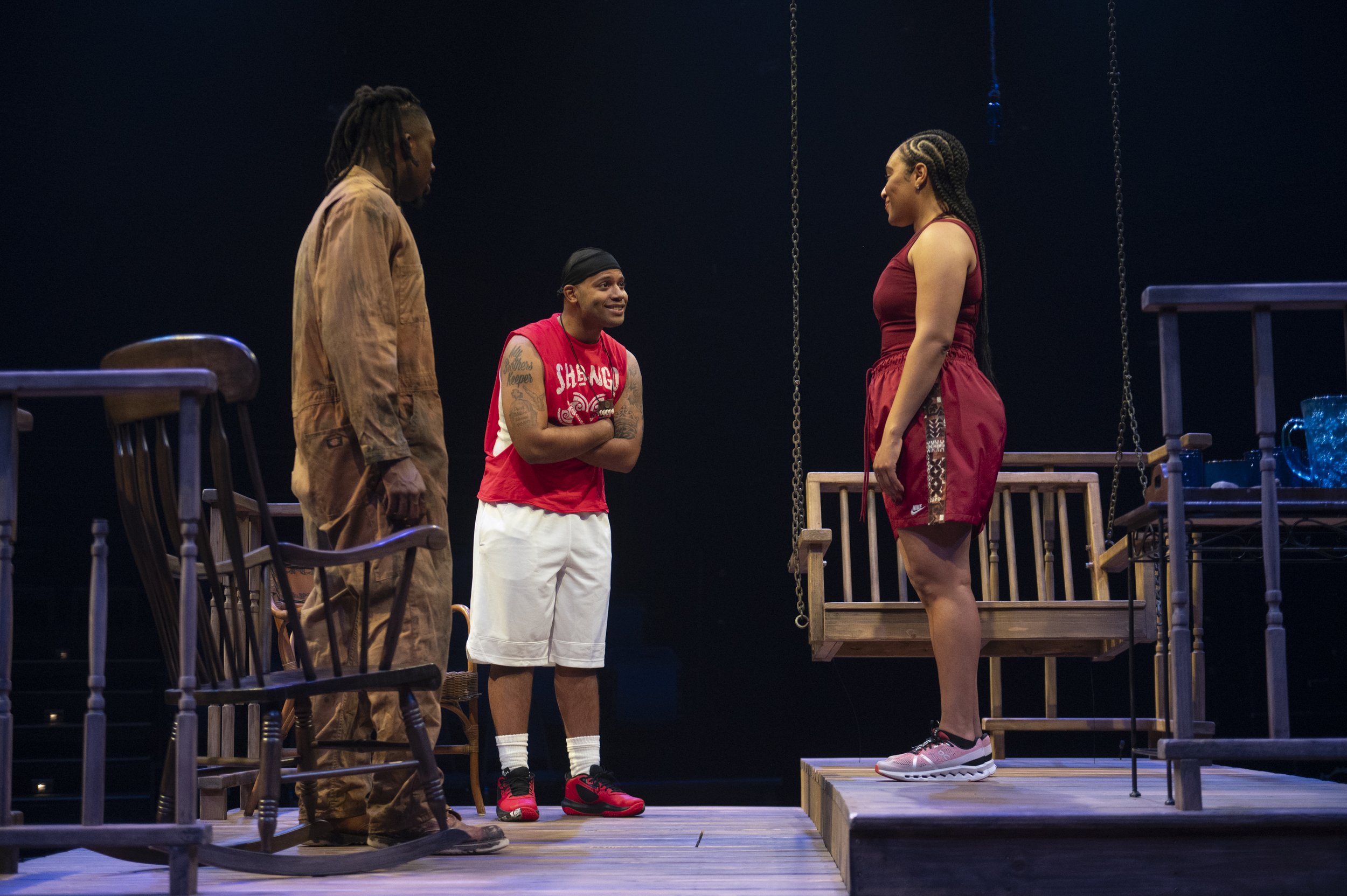In The Red and Brown Water Review
Oya: Dajzane Meadows-Sanderlin; Elegba: Kylen Phillips; Mama Moja: Cianon Jones; Egungun: Patrick Adu. Courtesy Photo.
By A’Keitha Carey
What happens when you bring Miami born Tarell Alvin McCraney, who is an Oscar winning powerhouse for Best Adapted Screenplay Moonlight and Washington, DC native, Broadway actress, director, educator, playwright, and vocal coach Caroline Clay together on a production? You get a spontaneous combustion! We witnessed love, passion, fire, desire, pain, jealousy, death, despair, disappointment and hurt throughout the play, In The Red and Brown Water.
Written by Tarell Alvin McCraney and directed by Assistant Professor of acting at the University of Iowa, Caroline Clay, this outstanding production premiered at The David Thayer Theatre and ran for two weekends, April 12-20. I attended the first two nights (Friday and Saturday) and interviewed several of the actors on Saturday afternoon. I wanted an introspective analysis of their experience, particularly what the character meant to them, if they saw themselves in their character, what they were walking away with from this experience, and what they wanted the audience to take away with them. The articulation of their process as well as what they wanted the audience to know about the characters were rooted in the spectrum of Blackness that filmmaker, educator, poet, and activist Marlon Riggs discusses in the 1995 documentary Black Is…Black Ain’t, which establishes that Blackness and Black identity are not monolithic.
The play explores African spirituality rooted in Yoruba religion, emphasizing Santerían Orisha’s and how these ancient deities have taken on human form, appearing as a modern-day Oya, Aunt Elegua, Elegba, Ogun, Shun/Oshun, Egungun, and Shango. I mean Shun/Oshun and her sidekick Nia had on pum pum shorts. Shun even had box braids with blonde highlights. It was clear that this story was about Black culture, and I am here for it! African symbolism is threaded throughout the play as characters create gestures associated with their specific deity. Color schemes corresponding with each Orisha is evidenced in the costuming and fabrics. There is even a beautiful hoodoo spiritualist who destroys Oya’s plans as she seeks “alternative” methods for conception. The practitioner is dressed in all white, carrying a cigar. The use of cigars in the spirit world is common practice as it is a device used to communicate with the ancestors and spirits as well as for offerings and prayer rituals.
So, what is this play about really about? Oya, the protagonist, is a talented track star who is as swift as what her deity represents—the wind. She devours her competition during local track and field events in the mythological town of San Pere, Louisiana and is recruited by “The Man from State” to attend college on a track scholarship. Due to a tragedy in her family, she is unable to attend. This life event sets the course for the rest of the play and fuels her emotional roller coaster.
Opening Night
My amazing hostess Jen Knights picked me up from the Grant Wood Residence at 7:30pm for the 8pm opening night performance of In The Red and Brown Water. We had a small hiccup with the seating but thankfully it was sorted out just in time. Upon entering the theater space, I was captivated by both the scenery, props, and the interaction of the actors. The provocative hanging fixture that was part octopus, jellyfish, and chandelier was mesmerizing. I sat down and began to stare deeply at the shape, identifying objects hanging from the tree. Was this a bottle tree? In Congolese communities during the 9th century, blue bottles were hung from trees to ward off and banish evil spirits. This tradition was brought to the Americas by enslaved Africans during the Trans-Atlantic Slave Trade, and it is practiced in the Southern states.
Nia: Delaney Waterman; Shun: E'mma Camara. Courtesy Photo.
The actors were engaged in preshow interactive conversations and playfulness that ranged from playing basketball, teasing each other, gossiping, and Oya running around the proverbial “track.” As I watched her, I noticed the level of focus and intensity displayed in her facial expressions, as well as her demeaner. This woman was carrying a heavy load, and I was curious to know her story.
A deep blue overcast produced a very radiant glimmer of light that encompassed the set which featured a porch with several chairs, as well as a swing. The blue light is emblematic of a practice (haint blue) in the south where people paint their ceilings blue to ward off ghosts or haints from their homes. This blue was symbolic of the sky and/or water and used to confuse or trick ghosts that passed by; it is believed that ghosts cannot cross water.
We were drawn in immediately by the intimacy of the set. As I familiarized myself with the space, and got comfortable in my seat, I noticed that Hip Hop music played softly in the background. When Beyoncé’s Formation came on, I began to make connections about female empowerment, women’s narratives, and Louisiana, all used as a backdrop for truth telling. I also observed that the theater was set up in-the-round, which was designed by Visiting Assistant Professor Bethany Kasperek. This construct offered a level of connection and sensual engagement that would be lost on the proscenium stage. Ogun, the Orisha of war, iron, and metal, and one of Oya’s lovers sat next to me. He wears overalls that depicts that he is a blue-collar worker. As he entered an exited his scenes, I could feel his energy as he rose from his seat. Ogun’s power was palpable, permeating for the surrounding audience members to experience.
The Play
After the cast concludes their pre-show shenanigans, the space clears, and they reenter with white cloths covering their heads. Are they ghosts or spirits? What is their relationship to the fabric, and how does it connect with the bottle tree and haint blue. I was already analyzing.
The Cast. Courtesy Photo.
I noticed gestures that represent Oshun, the Orisha of fertility, love, water, and sensuality such as holding her mirror to admire her beauty. Shango, the Orisha of male power and virility, who is associated with lightning and thunder wore a red t-shirt with Shango written on it, white shorts, and a black durag. He was the epitome of male aggression and dominance. Shango’s attitude was menacing to Oya’s mental and emotional health, as this was her lover of choice. Their relationship was emblematic of some contentious relationships between Black women and men.
This play includes all the intersectional politics: racial, sexual, parental, and cultural, while exploring deep topics such as mother daughter relationships, homosexuality, the comedic elements of Black mourning, all that goes (wrong) with Black church culture, and teen pregnancy. Elegba, the Orisha of the crossroads, known to be mischievous and a trickster was exactly that. His tall, thin frame transposed from a youth, young boy, and a teenage father. Within his precocious and often inappropriate dialogue, he reveals himself as a seer, sharing a recurring dream about Oya with her mother Mama Moja. We witness this recurring dream manifest throughout the play.
Each character was clearly portrayed through the actor’s skillful performance. It was evident that there was a deep investigation into their roles and that they were guided and pushed beyond their comfort zones. The language was raw with many f bombs being dropped as well as the use of the word nigga’, which had some white audience members clutching their pearls. Black culture, vernacular, and aesthetics were centered as we saw natural hairstyles, Afro/Afro puffs, braids, cornrows, locs, durags, red cups for that mixed drink collabo, double entendre reads, gold chains, street parties, and booty and coochie poopin’ by inappropriate aunties—it was Blackity Black and very real.
Shango: Michael Taylor; : Oya: Dajzane Meadows-Sanderlin; Ogun: Isaac Addai. Courtesy Photo.
“Clay’s vision for In the Red and Brown Water is inspired by the Brechtian impulses in McCraney’s writing. Brechtian theatre, developed and named after mid-century German theatre practitioner, playwright, and poet Bertolt Brecht, uses distancing effects, and dispenses with any illusion that presents the performance as real—thus there is an emphasis on theatricality. In the play, characters announce their own entrances and speak their own stage directions aloud” (https://theatre.uiowa.edu/news/2024/04/oyas-future-air-department-theatre-arts-prepares-final-mainstage-production-season-red), which is a form of acting that I was unfamiliar with but made sense as they took us down this journey with them.
The audience’s responses to the play the first night was starkly different from the second night. On the first night, the crowd was older, predominantly white, and they barely laughed at the jokes. Could it be that they couldn’t understand the cultural contexts? I observed many stoic faces and tense bodies throughout the entire show. During the second performance, I saw new things. I was able to take a deeper dive into the performance holding on to this more informed perspective from the actors from interviews. I witnessed the actors also taking a deeper dive into their roles, adding a little more flavah and playfulness. This night, the audience was younger and more diverse in terms of racial make-up. They laughed immediately and continued throughout the play. Everyone was disgusted at Shango. Every time he entered the scene, the audience audibly sighed with frustration. It was hilarious!
Well done everyone. Big ups to collaborator Kieron Dwayne Sargeant. His knowledge on African spirituality and Caribbean and African dance practices and aesthetics were beneficial, offering an authentic perspective, and ensuring that the performers honored the ancestors, culture, and Orisha’s in a respectful manner. Asé.
Director: Caroline Clay
Dramaturg: Rebecca Weaver
Stage Manager: Savanha Moore
Assistant Stage Manager: Emma Merkes
Choreographer: Kieron Sargeant
Set Designer: Bethany Kasperek
Lighting Designer: Bryon Winn
Costume Designer: Loyce Arthur
Sound Designer: Victor Maldonado
Photographer: Miranda Meyer
Cast:
Oya: Dajzane Meadows-Sanderlin
Elegba: Kylen Phillips
Ogun: Isaac Addai
Mama Moja: Cianon Jones
Aunt Elegua: Asha Keller
Nia: Delaney Waterman
Shun: E'mma Camara
Shango: Michael Taylor
O Li Roon/The Man From State: Jasper Rood
Egungun: Patrick Adu
Ensemble/Dance Captain: Garin Clinton-Nelson



